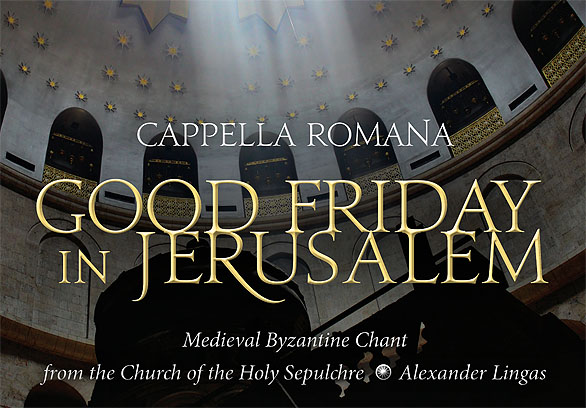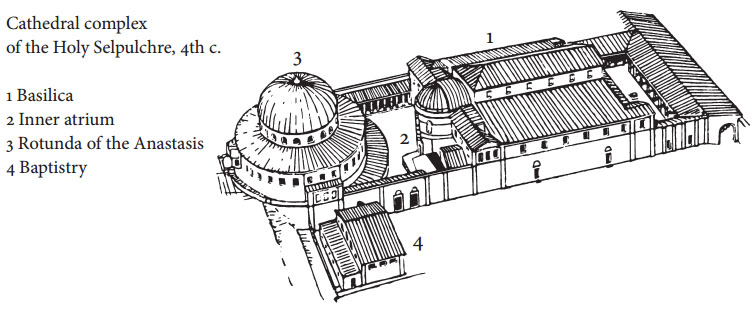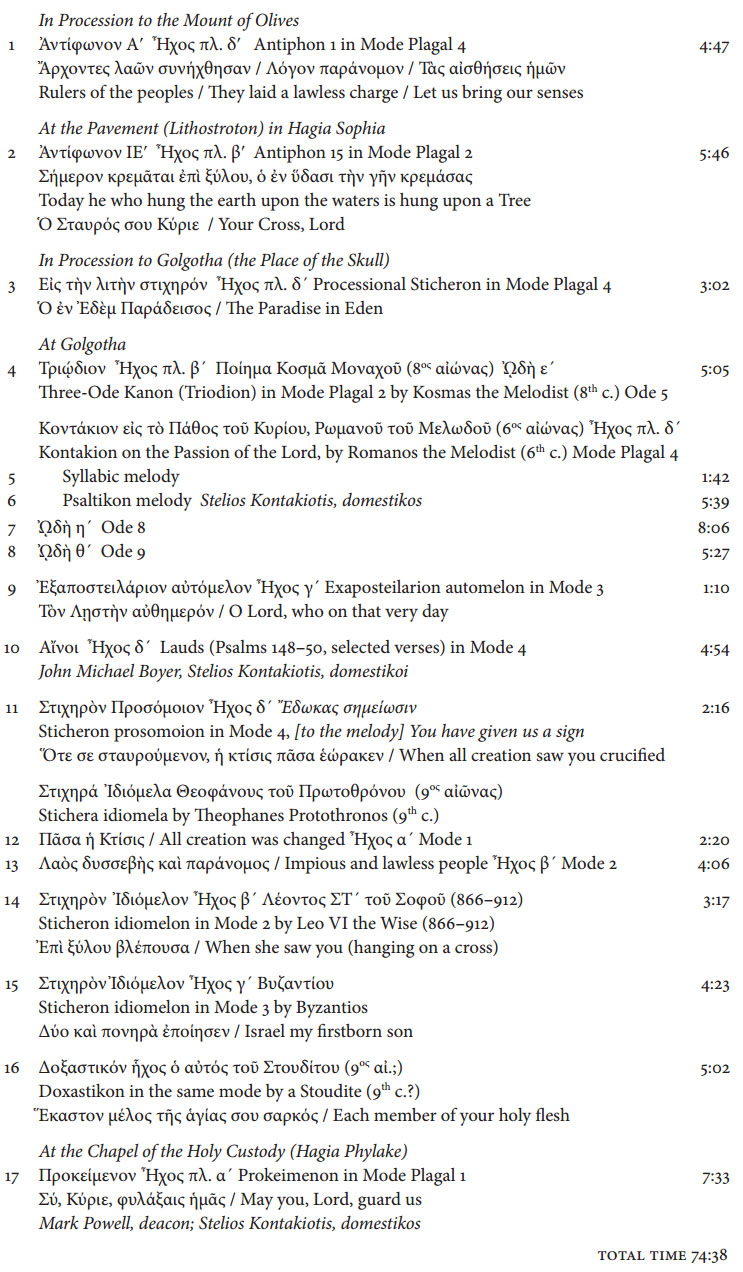Capella Romana: Good Friday in Jerusalem
10 April 2015Until the recent discovery of a few Greek sources for the urban rite of Jerusalem among the New Finds of the Holy Monastery of St Catherine on Mount Sinai, the most important surviving Greek witness to cathedral worship in the Holy City was the so called Typikon of the Anastasis. Copied in 1122, this manuscript (Greek Orthodox Patriarchate of Jerusalem MS Hagios Stauros 43) contains services for the seasons of Lent and Easter as celebrated prior to the destruction of the Holy Sepulchre complex by the Fatimid Caliph Al-Hakim in 1009 (and probably also, according to recent research (Galadza 2013), for many decades after its Byzantine reconstruction).
Older and newer chants presented without musical notation coexist in the Typikon of the Anastasis. Thus works from the apogee of Christian Palestinian hymnody—a period initiated by the liturgical works of Sophronios and continued by the eighth century poet-composers Andrew of Crete, John of Damascus and Kosmas the Melodist—are integrated with hymns by writers working within the traditions of the Constantinopolitan monastery of Stoudios.
The latter had, at the behest of its abbot Theodore, adopted a variant of the monastic liturgy of St Sabas at the beginning of the ninth century. The resulting Stoudite synthesis of Palestinian and Constantinopolitan traditions was a crucial stage in the formation of the cycles of worship employed in the modern Byzantine rite. The present recording features excerpts from the Service of the Holy Passion of our Lord Jesus Christ as it would have been celebrated in Jerusalem during the transitional period of its ritual Byzantinisation. An archaic cousin of the service celebrated in the modern Byzantine rite on Holy Thursday evening, this is a stational version of the office of early morning prayer (matins or orthros, literally ‘dawn’) in which eleven gospel readings narrate the events of the Passion of Jesus in a sequence beginning with his Last Discourse to his disciples (John 13:31–18:1) and ending with his burial (John 19:38–42). The texts and rubrics of the Typikon of the Anastasis form the basis of our reconstruction, supplemented by notated musical settings for its chants transmitted in manuscripts ranging in date from the tenth to the fourteenth centuries. Manuscripts with archaic and intervallically imprecise forms of Byzantine musical signs (neumes) were consulted alongside the earliest available versions of Passion chants in the readily decipherable Middle Byzantine Notation, a system that was employed from the later twelfth century until the notational reform by the ‘Three Teachers’ (Chrysanthos of Madytos, Chourmouzios the Archivist, and Gregorios the Protopsaltes) first introduced in 1814. Dr Ioannis Arvanitis, a leading authority on medieval Byzantine musical rhythm and performance practice, then edited and transcribed the chants into the Chrysanthine ‘New Method’ of Byzantine notation for use by the singers of Cappella Romana.
—Alexander Lingas
Capella Romana:
Alexander Lingas, artistic director and soloist
Stelios Kontakiotis, principal soloist
Spyridon Antonopoulos, John Michael Boyer, Constantine Kokenes, Mark Powell, melodists
Theodor Dumitrescu, David Krueger, Adam Steele, David Stutz, isokrates
Ioannis Arvanitis, performing editions
Its performances “like jeweled light flooding the space” (Los Angeles Times), Cappella Romana is a vocal chamber ensemble dedicated to combining passion with scholarship in its exploration of the musical traditions of the Christian East and West, with emphasis on early and contemporary music. Founded in 1991, Cappella Romana’s name refers to the medieval Greek concept of the Roman oikoumene (inhabited world), which embraced Rome and Western Europe, as well as the Byzantine Empire of Constantinople (“New Rome”) and its Slavic commonwealth.
Flexible in size and configuration according to the demands of the repertory, Cappella Romana is based in the Pacific Northwest of the United States of America, where it presents annual concert series in Portland, Oregon, and Seattle, Washington. It regularly tours in Europe and North America, having appeared at venues including the Metropolitan Museum of Art, Trinity Wall Street and Music Before 1800 in New York, the J. Paul Getty Center in Los Angeles, St. Paul’s Cathedral in London, the Pontificio Istituto Orientale in Rome, the Sacred Music Festival of Patmos, the University of Oxford, Princeton University, and Yale University.
Cappella Romana has released over twenty compact discs, including recent releases Tikey Zes: Divine Liturgy and Arctic Light: Finnish Orthodox Music. In addition to the present disc, other releases include Mt. Sinai: Frontier of Byzantium, Epiphany: Medieval Byzantine Chant and Byzantium 330–1453 (the official companion CD to the Royal Academy of Arts Exhibition), Byzantium in Rome: Medieval Byzantine Chant from Grottaferrata, The Fall of Constantinople, Richard Toensing: Kontakion on the Nativity of Christ, Peter Michaelides: The Divine Liturgy of St. John Chrysostom and The Divine Liturgy in English: The Complete Service in Byzantine Chant. Forthcoming recordings include music from medieval Cyprus, medieval Byzantine chant from the Great Church of Christ at Hagia Sophia, Constantinople, and the large-scale Slavonic choral work Passion Week by Maximilian Steinberg (1883–1946), a student and son-in-law of Rimsky-Korsakov and teacher of Shostakovich.
In 2010 it became a participant in the research project “Icons of Sound: Aesthetics and Acoustics of Hagia Sophia, Istanbul,” a collaboration between the Center for Computer Research in Music and Acoustics and the Department of Art & Art History at Stanford University, where the ensemble also performed in 2013 and will return in 2016-17.
Content of Good Friday in Jerusalem:
Contact and Booking Information
Cappella Romana 1017 SW Morrison St Ste 315, Portland, or 97205 USA tel +1.503.236.8202
cappellaromana.org










